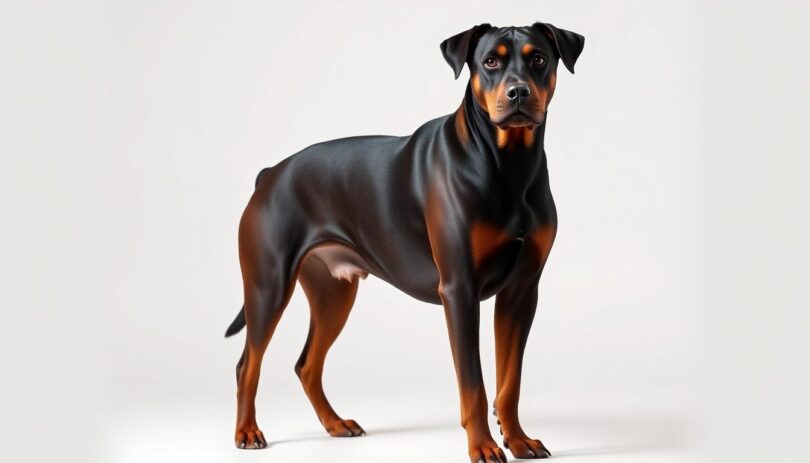Did you know mixed-breed dogs account for over 50% of U.S. canine companions? Among these unique hybrids, one stands out for combining power, brains, and devotion: the Doberman Rottweiler mix. This striking crossbreed merges two legendary working breeds into one remarkable pet.
Born from the Doberman Pinscher and Rottweiler lineages, these dogs inherit a balanced blend of traits. Their muscular build and alert expressions showcase their protective heritage. Yet many owners report a surprisingly affectionate side beneath that imposing exterior.
Proper socialization shapes these intelligent guardians into family-friendly companions. Early training helps manage their natural watchfulness while nurturing their loyal nature. Regular mental stimulation prevents boredom in this highly alert hybrid.
This article explores key aspects of caring for these powerful mixes. You’ll learn about their exercise needs, coat care routines, and common health considerations. Whether you’re considering adoption or simply curious about this unique crossbreed, we’ll provide actionable insights to help you understand their specific requirements.
Introduction to This Unique Hybrid
What happens when two iconic guardian breeds combine their best traits? This hybrid merges sleek athleticism with steadfast confidence, creating a four-legged companion equally suited for active adventures and loyal home life. Owners often describe these dogs as “living contradictions” – imposing yet affectionate, vigilant yet adaptable.
Breed Overview and Appeal
The mix inherits a striking balance of physical and mental traits. Expect a muscular frame paired with intelligent eyes that miss nothing. These dogs typically showcase either the Doberman’s streamlined silhouette or the Rottweiler’s broader build, often blending both into a unique physique.
Behaviorally, they offer the best of both worlds. The hybrid’s alertness makes them excellent watchdogs, while their deep-rooted loyalty fosters strong family bonds. Proper socialization helps them distinguish between normal interactions and genuine threats.
Highlights of the Mix’s Versatility
Three key factors make this hybrid adaptable:
- Adjustable energy levels that suit urban apartments or rural homes
- Natural protective instincts balanced with gentle playfulness
- Eagerness to learn through interactive training sessions
Whether serving as jogging partners or couch companions, these dogs thrive when their physical and mental needs are met. Their short coat requires minimal grooming, making them practical for busy households. Prospective owners should prepare for consistent training and regular health checkups to support their pet’s wellbeing.
Historical Roots and Breed Lineage
The tale of these working dogs begins in vastly different eras. One emerged from 19th-century Germany, the other traces back to ancient Roman legions. Their combined heritage creates a fascinating genetic blueprint for modern hybrid enthusiasts.
Guardian Legacies Through Time
Karl Friedrich Louis Dobermann crafted his namesake breed in the 1890s. As a tax collector and dog catcher, he needed a fearless protector. The result became renowned for loyalty and sharp intelligence.
Rottweilers boast even older origins. Roman armies used their ancestors to drive cattle across Europe 2,000 years ago. These mastiff-type dogs later thrived as butcher’s companions in Rottweil, Germany.
Both breeds share a common thread: purposeful design. Their physical power and mental acuity served specific human needs. Modern mixes inherit this legacy of utility, blending protective instincts with adaptable temperaments.
Breeders developed this cross to enhance desirable traits from both lineages. The goal? Create a versatile companion excelling in companionship and security. Understanding this background helps owners appreciate their pet’s natural behaviors and care requirements.
Distinctive Physical Characteristics
A striking blend of power and elegance defines this mixed breed’s appearance. These hybrids typically stand 24-27 inches tall at the shoulder, weighing between 70-100 pounds. Their physique showcases a perfect marriage of streamlined athleticism and substantial bone structure.
Size, Build, and Proportions
Muscular thighs and a deep chest create balanced proportions ideal for endurance activities. The ribcage extends well back, allowing ample lung capacity for vigorous exercise. Many specimens inherit the Doberman’s tapered muzzle paired with the Rottweiler’s broader skull.
This combination results in a low-maintenance athlete’s build. Weekly brushing manages shedding while distributing natural oils. Nail trimming every 3-4 weeks prevents foot issues during high-impact activities.
Coat, Color, and Markings
The coat varies from sleek single layers to dense double coats offering weather resistance. Dominant colors include rich blacks and warm browns, often accented with rust-colored markings above the eyes and chest. Some display the classic Doberman-style tan points or Rottweiler-inspired mahogany patches.
Regular grooming sessions strengthen the bond between pet and owner while monitoring skin health. These maintenance routines complement the breed’s natural cleanliness, making them suitable for indoor living. Their physical traits demand daily exercise – think long walks combined with agility training.
Understanding Temperament and Behavior
Every dog has a unique personality, but this mixed breed stands out with its dynamic blend of energy and devotion. Their behavior reflects a fascinating balance between working-dog intensity and family-oriented affection. Owners often describe them as “full-time students” who thrive on learning new skills.
Energetic and Intelligent Qualities
These athletic companions require at least 90 minutes of daily activity. Interactive games like flirt pole chasing or scent work channel their physical stamina. Mental challenges prove equally vital – food puzzles and obedience drills prevent destructive boredom.
Their sharp minds absorb commands quickly when training uses positive reinforcement. Many excel in canine sports like agility or dock diving. Consistency remains key, as their problem-solving skills can lead to creative mischief without guidance.
Family Loyalty and Protective Instincts
Deep bonds form quickly with household members, especially children raised with the dog. Watchful eyes track family movements, ready to intervene if sensing distress. Strangers receive polite but reserved greetings until trust develops through proper introductions.
Natural guarding tendencies emerge through alert posturing or strategic positioning near doors. Early socialization teaches appropriate responses to visitors. Structured routines help balance protective instincts with relaxed home life.
Grooming, Health, and Nutritional Care
Maintaining a hybrid dog’s health requires attention to both exterior and interior needs. Consistent care routines prevent common issues while supporting energy levels. Let’s explore practical strategies for coat maintenance and dietary balance.
Essential Grooming Practices and Coat Care
Weekly brushing sessions remove loose hair and distribute skin oils. Use a rubber curry comb for short coats – this stimulates circulation while catching debris. Trim nails every 21 days to avoid joint strain during high-impact activities.
The mix’s coat varies between parent breeds. Some inherit the Doberman’s sleek fur, others the Rottweiler’s denser undercoat. Clean ears biweekly with vet-approved solutions to prevent infections common in active dogs.
Balanced Diet and Nutritional Guidelines
Feed 3-4 cups daily of high-protein food (26% minimum) split into two meals. This prevents gastric torsion, a risk for deep-chested breeds. Look for formulas with chicken or fish as first ingredients, supplemented with omega-rich fats.
Incorporate complex carbs like sweet potatoes for sustained energy. Schedule annual dental checkups alongside routine vet visits. Proper nutrition supports muscle recovery after exercise and maintains glossy coats.
Always provide fresh water, especially after workouts. Avoid fillers like corn or soy that offer limited nutritional value. Pair quality meals with consistent grooming for optimal wellbeing.
Daily Exercise and Mental Stimulation Needs
Active hybrid breeds thrive when their energy finds purposeful outlets. This athletic mix requires structured physical challenges paired with brain-engaging tasks to stay balanced. Meeting these needs prevents boredom-related behaviors while supporting overall wellness.
Customized Physical Activity Routines
Tailor exercise plans to your dog’s age and energy levels. Young adults benefit from 90-minute daily sessions combining running, hiking, or swimming. These activities build endurance while satisfying natural instincts to patrol and explore.
Interactive games like flirt pole chasing or fetch provide focused energy release. Rotate activities weekly to maintain engagement – try agility courses one day and water retrieval the next. Senior dogs still need modified movement through shorter walks or gentle play.
Puzzle Play and Mental Enrichment Ideas
Challenge sharp minds with food-dispensing toys that reward problem-solving. Hide treats around your yard for scent-tracking adventures. Teach new commands during 10-minute training sprints to reinforce obedience skills.
Rotate puzzle toys weekly to prevent mastery boredom. Combine physical and mental tasks by creating obstacle courses with directional cues. These strategies reduce anxiety while strengthening the bond between pet and owner.
Training & Socialization for a doberman cross with rottweiler
Successful development of this hybrid companion hinges on structured guidance and early exposure. Their intelligent nature demands consistent mental engagement paired with diverse social experiences. Proper training transforms innate protective instincts into controlled responsiveness.
Early Socialization Techniques
Introduce puppies to varied environments between 8-16 weeks. Start with quiet parks before progressing to busier areas. Pair new experiences with high-value treats to build positive associations.
Arrange controlled meetings with vaccinated dogs and calm adults. Rotate interaction partners weekly to prevent overattachment. Exposure to household noises like vacuums reduces anxiety triggers later in life.
Effective Positive Obedience Training
Clicker training works exceptionally well for this intelligent mix. Reward desired behaviors immediately with praise and small food rewards. Keep sessions under 15 minutes to maintain focus during formative months.
Enroll in group classes to reinforce commands around distractions. Practice “leave it” and “watch me” drills daily. Consistent routines help establish household rules while strengthening trust between pet and owner.
Ongoing reinforcement prevents regression during adolescence. Continue introducing novel situations throughout the dog’s life. Well-socialized mixes become adaptable companions who thrive in family environments.
Managing Potential Health Concerns and Preventative Care
Proactive care forms the foundation for maintaining your dog’s long-term wellness. These athletic mixes often enjoy robust health but require vigilant monitoring for breed-specific conditions. Understanding risk factors helps owners partner effectively with veterinarians.
Common Conditions and Prevention Strategies
Large breeds face higher risks of hip dysplasia and gastric torsion. Watch for subtle signs like reluctance to jump or rapid breathing after meals. Schedule biannual vet exams to catch issues early – X-rays can assess joint health before symptoms appear.
Prevent bloat by using slow-feed bowls and avoiding vigorous exercise after meals. Maintain lean muscle mass through tailored exercise programs that protect developing joints. Reputable breeders provide health clearances showing parental screening for heart conditions and genetic disorders.
Consistent home checks complement professional care. Monitor gum color, weight fluctuations, and energy levels weekly. Combine high-quality nutrition with joint supplements if recommended by your vet. Early intervention often leads to better outcomes for common canine health challenges.
Final Reflections on Cultivating a Lifelong Bond
Building a life with a loyal companion requires more than love—it demands dedication. This remarkable mix thrives when owners embrace their dual nature as both protector and playmate. Their sharp intelligence and unwavering loyalty blossom through consistent care routines and purposeful engagement.
Commitment to regular exercise and mental challenges strengthens your bond while maintaining physical health. Proactive vet visits and quality nutrition form the foundation for longevity. Training sessions evolve into shared language, deepening trust with every mastered command.
View your pet as an evolving partner rather than a static responsibility. Puppyhood’s energy transitions into adulthood’s steady companionship, each phase offering new ways to connect. Senior years become opportunities to adapt care while cherishing shared memories.
True partnership emerges when you honor their unique blend of strength and sensitivity. Prioritize their needs through every life stage, and you’ll gain more than a pet—you’ll forge an unbreakable bond built on mutual respect and joyful coexistence.
FAQ
How long do Doberman-Rottweiler mixes typically live?
This hybrid usually lives 10–12 years. Regular vet checkups, a balanced diet, and consistent exercise help maximize their lifespan. Watch for breed-specific issues like hip dysplasia or heart conditions.
Are these dogs suitable for families with young children?
With proper socialization training, they can thrive in families. Their loyalty and protective instincts require supervision around kids. Early exposure to children helps build positive interactions.
What type of exercise routine works best for this mix?
Aim for 60–90 minutes of daily activity. Combine brisk walks, jogging, and puzzle play to meet their high energy level. Mental stimulation through scent games or agility courses prevents boredom.










Leave a Comment